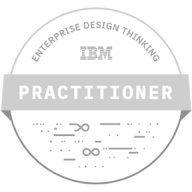
Want to know more? — Subscribe
ChatGPT, AlphaCode, and Midjourney have become synonymous with innovation and creativity. Generative AI tech stack powers their magic and is extremely popular among everyone wanting to harness the potential of these models. There are no bounds for this technology. It can generate human-like text, outstanding artwork, and even music.
The generative AI market is expanding at 34.3% and may reach $110.8 billion by 2030. The labor productivity with this technology may grow from 0.1 to 0.6 percent annually by 2040. When combined with other technologies, like automation, generative AI can contribute from 0.2% to 3.3% to annual productivity growth.
With over nine years of expertise, Softermii can unveil the inner workings of the generative AI stack. You'll delve into the tech stack's significance, the underlying technologies powering generative AI, programming languages, support infrastructure, and much more. Join us as we unravel the components of a tech stack that empowers your company for success.
Why a Tech Stack Matters
A tech stack is a tool, framework, and technology combination used to build and run an application. A technology stack of generative AI assumes a much more profound role. It encompasses everything from the datastoragesolutions and machine learning frameworks to the APIs and user interface tools. But why is this assembly of technologies so pivotal?
Foundation of the Project
A tech stack is a foundational layer upon which your generative AI project is built. It dictates how different parts of your application communicate, how data is processed, and how results are delivered. A strong foundation ensures stability, while a shaky one can lead to complications later.
Pivotal to Project Success
A well-curated generative AI technology stack ensures smooth implementation and efficient operation of applications. Developers can achieve desired outcomes with the right set of tools and frameworks. They can avoid unexpected issues and meet project milestones without unnecessary delays.
Scalability & Future-proofing
The dynamic nature of healthcare and fintech areas necessitates AI models that can scale with evolving data and user demands. An adaptable tech stack can accommodate the AI tech trends. Moreover, as technology pivots frequently, it's important to select tools that remain relevant. A forward-thinking tech stack ensures that your project stays immune to technological redundancy.
Performance Considerations
The efficiency of AI models depends on the underlying technologies. A robust tech stack of generative AI guarantees optimal performance, swift data processing, and timely results. These factors are paramount in sectors like e-commerce, where user experience can hinge on the speed and accuracy of AI-generated content.
Security & Compliance
The generative AI stack is pivotal in ensuring that data is safeguarded and compliance standards are upheld. Tools with built-in security features or compatibility with leading security protocols become indispensable.
Interoperability
Generative AI systems often interact with other software, systems, or datasets. The tech stack should allow seamless integration, fostering smooth operations within a broader ecosystem.
Cost Implications
An optimized generative AI technology stack can lead to cost savings in the long run. Businesses should select efficient tools that are tailored to the project's requirements. Thus, they can reduce costs related to maintenance, unexpected troubleshooting, and potential technology revamps.
Community & Support
Established technologies in a tech stack of generative AI often come with active communities. They can be invaluable for troubleshooting, updates, and harnessing the collective knowledge of developers worldwide. Such communities stand testament to the tech stack component's vitality and continuous enhancement.
Technologies Behind Generative AI
Each technology behind generative AI enables machines to generate new content, simulate data, or model intricate patterns. Let's explore some of these fundamental technologies.
Neural Networks: The Building Blocks
At the heart of most AI models, especially in the generative domain, lie neural networks. They are inspired by the human brain's architecture, consisting of interconnected neurons. These computational models can learn and make independent decisions by analyzing data.
Neural networks can model complex non-linear relationships. It makes them invaluable for image recognition, predictive modeling, and various generative tasks.
Natural Language Processing (NLP)
This domain of AI focuses on the interaction between computers and human language. It aims to enable computers to understand, interpret, and generate human language in a meaningful way.
It drives a multitude of applications that require an understanding of human language. For example, NLP apps in healthcare, sentiment analysis, chatbots, and language translation. In generative AI, NLP is essential for tasks like automated content creation, text summarization, and more.
Computer Vision Technologies
Computer vision empowers machines to interpret and make decisions based on visual data. They can identify patterns, objects, and emotions in images and videos.
In generative AI, computer vision aids in image/video generation and facial recognition tasks. Style transfer and image-to-image translation techniques are also rooted in computer vision.
Reinforcement Learning
It's a type of machine learning where an agent learns as it interacts with its environment. It then receives feedback in the form of rewards or penalties. This trial-and-error approach allows the agent to learn optimal strategies over time.
Reinforcement learning can be used to optimize algorithms that generate content. It can ensure the models produce the most relevant and high-quality outputs.
Generative AI Models
Generative AI models have become powerful tools for simulating data, creating content, and modeling complex patterns. Let's explore the most influential models in this space and understand their mechanics.
GANs (Generative Adversarial Networks)
GANs consist of two neural networks. A generator and a discriminator are set in a contest: the generator produces data samples, and the discriminator evaluates them. The generator produces data that the discriminator can't distinguish from real data.
GANs can generate realistic images. They've been used in:
- art creation;
- image synthesis;
- style transfer;
- creating realistic video game environments.
LSTMs (Long Short-Term Memory Networks)
LSTMs are a Recurrent Neural Network (RNN) type that can remember patterns over extended periods. They use gates that regulate the flow of information, allowing them to remember or forget things selectively.
LSTMs are effective in tasks that involve sequential data:
- time series forecasting;
- speech recognition;
- natural language processing.
VAEs (Variational Autoencoders)
VAEs are autoencoders that learn a probabilistic mapping between the data and latent space. They work by compressing data into a latent space and then reconstructing it. This procedure introduces random variances, creating new yet similar data samples.
VAEs generate data samples, like creating facial images or morphing ones. They have also become useful in anomaly detection. VAEs can signal if an input data point differs significantly from the trained data.
Transformers
Although transformers are not strictly generative, these architectures have changed the NLP landscape. They use attention mechanisms to assess the importance of different parts of the input data. It allows for more adaptable and context-aware processing.
Transformers power BERT and GPT models that excel in text generation, translation, and other tasks.
GANs (Conditional Generative Adversarial Networks)
Building upon the GAN framework, CTGANs enable the generation of data samples while being conditioned on specific input parameters. It provides better control over data generation.
CTGANs find utility in creating particular images or sounds based on conditions. They can also model complex data distributions with specific constraints.
Core Programming Languages and Libraries for Generative AI
Understanding fundamental programming concepts is integral within the field of generative AI. Core languages, frameworks, and libraries establish the building blocks for creating sophisticated AI models.
Languages for Generative AI: The Syntax of AI
The choice of programming language forms the foundation of any AI project. Different languages bring varied strengths to the table, providing structure, logic, and functionality.
|
Languages for Generative AI |
||
|---|---|---|
|
Language |
Overview |
Advantages |
|
Python |
Python is the primary language for AI and ML projects, including generative AI. This popularity arises from its simplicity, readability, and extensive library support. |
|
|
R |
Renowned for its statistical prowess, R offers a unique data analysis and modeling perspective. They can be beneficial in specific generative AI tasks. |
|
|
C++ |
C++ is a high-performance language known for its speed and efficiency. |
|

|
||
Frameworks for Generative AI: The Architect's Blueprint
Frameworks lay down comprehensive architectures and methodologies. They guide developers with a structured approach to AI modeling.
|
Libraries for Generative AI |
||
|---|---|---|
|
Library |
Overview |
Advantages |
|
PyTorch |
Developed by Facebook's AI Research lab, PyTorch is known for its dynamic computation graph. This feature offers intuitive modeling and flexibility in deep learning development. PyTorch is a favorite among developers for prototyping and building neural networks. |
|
|
Caffe |
A deep learning framework known for its speed and modularity. |
|

|
||
Libraries for Generative AI: The Toolbox
Libraries offer predefined tools and functions that streamline the app development process. They provide solutions, shortcuts, and frameworks that can simplify complex tasks. Certain open-sourcelibraries have become standard choices for generative AI due to their efficiency, flexibility, and community support.
|
Libraries for Generative AI |
||
|---|---|---|
|
Library |
Overview |
Advantages |
|
TensorFlow |
Caters to tasks like basic regression models and advanced neural networks. |
|
|
Keras |
Provides a Python interface for artificial neural networks. Perfect for beginners and quick prototyping. |
|

|
||
Support Infrastructure
Generative AI, with its advanced computational requirements, relies on robust infrastructure. The hardware powering these systems ranges from specialized hardware units to cloud platforms. Here's a breakdown of the essential support infrastructure components.
Graphics Processing Units (GPUs)
Designed for rendering high-quality graphics in video games, it's now widely used for training deep learning models. Their architecture, built around thousands of small cores, is adept at handling multiple tasks simultaneously. GPUs are perfect for the parallel processing demands of neural networks. Their applications include:
- accelerating the training of large-scale neural networks;
- rendering complex graphics;
- facilitating real-time processing in generative AI projects.
Tensor Processing Units (TPUs)
Developed by Google, TPUs are custom-built to accelerate machine learning tasks. They are optimized for TensorFlow mathematical operations, providing significant speed-ups.
Compared to GPUs, TPUs excel in faster computation for tasks like matrix multiplications commonly found in neural network calculations. They are particularly valuable for enhancing the performance of large-scale machine learning tasks. They include generative model training and inference, especially within Google's ecosystem.
Cloud-based Solutions: AWS, Azure, Google Cloud
Cloud providers like AWS, Azure, and Google Cloud offer services to support, train, and deploy AI models. Their applications include:
- hosting and scaling AI apps;
- storing large datasets;
- accessing pre-trained models;
- facilitating collaboration among teams distributed globally.
APIs for Quick Integration: Google API.AI, IBM Watson, Microsoft Luis
APIs simplify the integration of AI capabilities into applications. Google API.AI, IBM Watson, and Microsoft Luis offer pre-built functionalities, reducing the time and effort needed to embed AI-powered features. Developers can easily integrate natural language processing or image recognition into their applications.
APIs allow businesses to harness AI benefits without deep technical expertise. This process leads to quicker integration, reduced development cycles, and immediate access to AI features.
Data and Data Management
While the quality of a building's foundation determines its strength, AI models rely on the data they're trained with. The nature, quality, and management of data determine the results of AI projects. For example, vector databases can operationalize the data. Here, we navigate the essential facets of data and its management in the context of generative AI.
Importance of Quality Data
Quantity can often be mistaken for quality. On the one hand, large datasets can offer a comprehensive view. Yet, quality data, free from biases and inaccuracies, ensures the AI model's results are reliable and unbiased.
It's extremely important when using AI for pharmacy and healthcare, as quality data translates to accurate predictions. Inconsistent or polluted data can mislead the AI. It will then result in unreliable outputs and potentially compromise decision-making.
Data Annotation and Labeling
The data should be annotated or labeled for supervised learning models to provide a learning baseline. By doing so, raw data becomes meaningful and usable for training.
Correctly annotated data enables the model to learn patterns, correlations, and relationships. Mislabeling or inconsistent annotations can lead to inaccurate predictions.
Data Privacy and Ethical Considerations
As AI systems ingest vast amounts of data nowadays, ensuring that the data used respects individual privacy and is ethically sourced is vital. Respect for user privacy and clear data usage policies build trust and prevent potential legal and ethical pitfalls.
GDPR, HIPAA, and Other Regulations
Several regulations set standards for data protection and privacy. Some of the key ones are:
- General Data Protection Regulation (GDPR) in the EU;
- Health Insurance Portability Accountability Act (HIPAA) in the US.
You must adhere to these regulations to ensure compliance and avoid severe penalties. This approach demonstrates a commitment to protecting individual rights and data privacy.
Conclusion
Generative AI technology plays a big role in our daily lives, from online content to how we interact with machines. A generative AI tech stack behind it is more than a collection of tools and technologies as it's the foundation for your project.
It ensures smooth implementation so your business can achieve project milestones without unexpected challenges. It's vital for scalability and performance, particularly in evolving industries like e-commerce that rely on generated content. The generative AI stack is pivotal in maintaining data security and complying with industry standards.
To create a personalized generative AI solution, we invite you to engage with the seasoned experts at Softermii. Contact us now, and we'll develop a solution that aligns precisely with your needs.
Frequently Asked Questions
How to protect a generative AI model from unauthorized access?
Protecting a generative AI model requires a multi-faceted approach:
- Authentication and Authorization. Ensure to have strong user authentication systems and only grant access to authorized personnel.
- Encryption. Store models and data in encrypted form, both in transit and at rest.
- Audits Trails. Maintain logs to track all access and modifications to the model. It can help in tracing any unauthorized activities.
- Firewalls and Intrusion Detection Systems. They can monitor and prevent malicious activities.
- Updates and Patches. Keep software, libraries, and frameworks up-to-date to address potential vulnerabilities.
How are generative AI models trained?
Generative AI models are trained with large amounts of data. Here are the main stages of their training:
- Data Collection. Gathering relevant and quality data.
- Data Preprocessing. Cleaning and organizing the data into a usable format.
- Model Architecture Selection. Choosing an appropriate generative model structure.
- Training. Feeding the data into the model and using algorithms to improve its performance. This stage often involves a feedback loop where the model's outputs are compared against real data.
- Evaluation. Using separate datasets to test the model's performance to ensure its accuracy.
- Iteration. Refining and retraining the model based on evaluations until desired performance is achieved.
What components make up the generative AI tech stack?
The individual components are crucial in a generative AI tech stack. Yet, their integration drives the seamless AI software development and deployment. The tech stack for generative AI encompasses the following:
- Programming Languages. Python, R, and C++ are the most common choices.
- Frameworks and Libraries. TensorFlow, PyTorch, and Keras offer predefined functions and structures for creating AI models.
- Hardware Accelerators. GPUs and TPUs to speed up computation-intensive tasks.
- Cloud Platforms. AWS, Azure, and Google Cloud provide scalable infrastructure for training and deploying models.
- API. Google API.AI, IBM Watson, and Microsoft Luis enable the integration of AI capabilities into existing applications without building from scratch.
Can generative AI "create" content entirely on its own?
Generative AI software is designed to generate new content based on patterns they've learned from data. While these models can produce novel outputs, their creations are based on existing data and patterns they've been trained on. Human intervention is crucial in training, fine-tuning, and guiding these models. The initial setup, algorithm choice, and purpose for which the model is designed also come from human decisions.
What are the primary challenges in generative AI models?
Understanding and addressing the generative AI challenges is important for its successful implementation and trustworthiness. Some of them include:
- Data Quality and Quantity. Models need vast amounts of high-quality data for effective training, which may not always be accessible.
- Training Complexity. Generative models, especially deep learning ones like GANs, can be unstable during training.
- Bias and Fairness. Like other AI models, generative models can perpetuate or amplify biases in their training data.
- Overfitting. There's a risk of models becoming too specialized in the training data. They then become less effective with new, unseen data.
- Interpretability. With deep generative models, it can be challenging to understand how they make decisions or derive outputs.
- Computational Resources. Training models can be resource-intensive, necessitating powerful hardware.
How about to rate this article?
19 ratings • Avg 4.6 / 5
Written by:
























